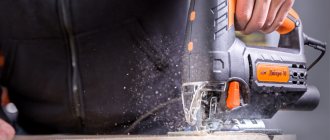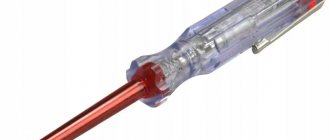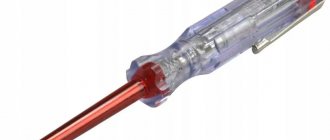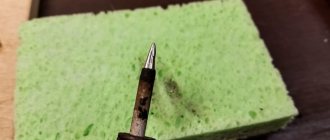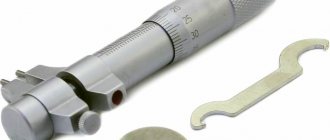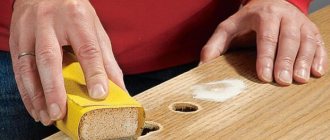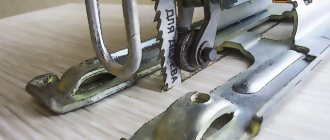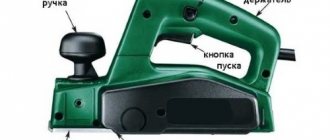Rating of the best electric jigsaws
| Place | Model | ||
| 1. | Makita 4329 450 W | Prices | Review |
| 2. | BOSCH PST 700 E 500 W | Prices | Review |
| 3. | BISON L-400 400 W | Prices | Review |
| 4. | Interskol MP-85/700E 700 W | Prices | Review |
| 5. | VORTEX LE-65 650 W | Prices | Review |
How to work with a jigsaw: features and rules
The electric jigsaw cuts unevenly. There is no need to rush and use force here. It is better to cut slowly and press the tool lightly against the material.
When working with a jigsaw, you should follow the rules
There is a small educational program on how to cut with a jigsaw exactly in a straight line, and so that the blade does not slip:
- While sawing you need to keep an eye on the file . As soon as it becomes a little dull, it should be replaced. When the file is dull, it moves away and chips appear.
- It is necessary to ensure that the file does not overheat , otherwise the teeth will quickly become unusable.
- Each type of file is designed for a specific material .
- The power of a tool directly affects its performance . The higher the power, the more different materials it can cut.
- Dense materials (countertops, laminate) can be sawed with a file with large teeth . Fiberboard and plywood are easy to cut with a fine-tooth saw .
- For a more even cut, you can use appropriate devices - stops or guide rails .
Any material can serve as a guide. The main thing is that it has a smooth edge and the ability to correctly align and fix it.
How can you cut metal tiles?
It is the presence of protective layers and the relatively small thickness of the sheet that requires the use of a special cutting tool. To cut the surface of a metal tile into pieces with the required dimensions and shape, you can use the following equipment:
- jigsaw;
- scissors for working with metal;
- hacksaw with fine teeth;
- electric nibblers;
- special circular saw with carbide teeth.
Nibblers are designed for straight and shaped cutting of sheet steel up to 2.0 mm; when cutting sheet metal, they do not deform or bend the cut edge of the sheet.
Nibblers are used when fast curved cutting of material is required, without heating the metal. They are small in size and convenient for work. A special holder allows you to rotate the scissors as needed when cutting, which speeds up the work.
Conventional metal scissors are used less frequently; they can be used when it is necessary to cut a small piece of sheet metal. Their use is not so desirable, since after cutting, uneven edges may remain.
A hacksaw for metal is also used for cutting, but it only allows you to make straight cuts. There are a lot of files that are suitable specifically for working with sheets of metal tiles, but this process is very lengthy and complex. Hand saws can be used only when cutting a small part of the material is required; a hacksaw is not suitable for large areas.
By following these simple rules, you can quickly and efficiently cut sheets of metal tiles of the required size.
Every man, being a true owner, must not only have repair tools in his arsenal, but also be able to use them in practice. We will talk about one of the modern tools, namely the jigsaw. Let's figure out what kind of device this is and how to work with it.
An electric jigsaw is designed for cutting
various sheet materials. Depending on the purpose, jigsaws are:
- professional;
- semi-professional:
- household
The differences lie in the technical characteristics and functionality of the tools.
Before you learn how to use a jigsaw, you need to familiarize yourself with its structure. The tool consists of:
- Aluminum housing.
- Electric motor. A powerful device will be able to cut thicker and stronger material.
- Gearbox covers.
- Pendulum control buttons. The pendulum mechanism allows you to make an accurate cut of materials with low density (soft wood, plywood, foam).
- Covers and brackets that ensure safe operation.
- Support roller for guiding the saw.
- Chip blower regulator.
- Regulator of the number of saw strokes, on which the speed of its movement depends.
- Plate tilt regulator. It allows you to cut wood at an angle of 15, 30, 45 and 90 degrees.
- Laser guide. Allows you to adhere to the drawn cutting line.
- A quick-release chuck that performs the functions of a saw.
- A battery, thanks to which you can cut with a jigsaw for some time without connecting to the network.
How to make a perfect cut with a jigsaw
To get a correct, beautiful and straight cut, you need to follow the following recommendations.
Selection of cutting blade
For shaped and fine work, it is better to take thin files . If you need to make a complex pattern, you need to use files with 2 cutting edges . The leading edge guides the main cut, and the rear edge makes the saw maneuverable, preventing scraps.
Fastening material
Many people neglect such a simple rule as fastening the material. It's one thing when the structure itself is bulky . There is no need to pin anything here. But if you need to cut, for example, a sheet of plywood, you can’t do without fasteners. The material is light and without fixation you can ruin everything.
Why can a jigsaw cut crookedly?
Not everyone knows how to saw off a workpiece smoothly with a jigsaw. The tool is light and without sufficient skill, the entire cut can go crooked .
Why does this happen:
- No experience with the tool.
- Saw blade with defects.
- Play in the guide roller. There may be 2 reasons: wear of the internal part and failure of the mounting holes.
- Rod wear. With such a malfunction, a large backlash occurs.
These are the most basic faults. There may be others, so you need to take all points into account.
Various methods are used to obtain an accurate cut.
What to do if you have problems with accuracy
Below we will look at how to cut smoothly with a jigsaw and get an accurate cut.
Sawing with a saw table
Often you have to cut out round or oval elements . You can't do without a saw table. On the underside of the tabletop you need to secure the jigsaw with the file facing upwards. Secure the start and stop buttons to the side. All that remains is to move the material in the right direction.
Sawing with a guide bar
The tire looks like a long ruler 1.3-1.5 meters . A groove is made in it and the jigsaw moves along it. The file must be adjusted along the cutting line, and the tire must be secured with a clamp. When sawing, the tool should be guided strictly along the tire.
Changing the rod
In standard models, the rod is a thin metal plate with a complex shape. Under high load there is a possibility that it will burst. The part must be replaced, which can be easily found on the market or in a store. When the jigsaw is disassembled, it is advisable to record on the camera exactly how everything is assembled inside it and in what order, so that later, after repair, unnecessary parts are not discovered. Next, the part is removed and taken to the market so that there is an opportunity to buy exactly the same there. After installing the new rod, lubricant is applied.
General cutting principles
To know how to cut smoothly with a jigsaw, there are several generally accepted rules.
How to cut wood, chipboard, plywood
To saw wood and its analogues (chipboard, plywood, fibreboard, laminate, chipboard), you need to use saw blades with a pitch of 3-4 mm and a maximum stroke frequency . The jigsaw should be moved slowly, pressing against the workpiece. If the cut is made quickly, then a pendulum stroke of the saw blade is used.
How to cut ceramics, porcelain tiles
When working with such materials, the tool should never be pushed. For ceramics, blades made of hard alloys of a certain length are suitable; for porcelain stoneware, diamond blades .
How to cut metal
For such purposes, use a fine-toothed file with a pitch of 1-2 mm , with a low stroke rate and without a pendulum. When working, only smooth movements, without pressing on the tool.
How to cut plexiglass, plastic
To saw off this type of material, use a file with a fine tooth . Provided that the pendulum stroke should be set to the minimum value.
Choosing the right tool
A few recommendations from experienced professionals will help you choose the right tool for the job.
For cutting at home, a household or semi-professional D-shaped jigsaw, which can be operated with one hand, is sufficient. The more power, the heavier the jigsaw, and it will be more difficult for it to cut smoothly.
A step speed controller, an electronic stabilizer and a pendulum stroke will greatly facilitate the cutting process. The presence of a plastic pad on the sole will allow you to securely secure the machine to the cutting blade. Useful features include built-in airflow and lighting.
It is worth paying attention to the fastening of the canvas. Some models have a restriction that does not allow the use of any file.
It is not recommended to cut boards with a jigsaw; there are circular saws and hacksaws for this. Although a powerful tool can cope with the task, it is unlikely that it will be possible to achieve a perfectly even cut.
Each jigsaw model differs in shape, so before purchasing it is worth holding the tool in your hand, and, if possible, testing it directly in the store.
Features of cutting round and oval elements
Before cutting out a circle or oval, you need to mark the workpiece . A hole slightly larger than the saw blade is drilled in the material. For elements with curved lines, a narrow file will be required. The cutting process should be slow.
If you need a circle of the correct shape, then use a circle cutter . A stop (compass) is fixed in the center of the circle and cut with a narrow blade. Here it is advisable to focus on the file itself.
There is no need to drill a hole in the material . The jigsaw must be installed behind the marking line, always with the edge of the sole. The angle should be increased until the workpiece is cut through. Then the jigsaw should be stopped, the file removed and returned to its normal position. You need to reach the marking line gradually, slightly rounding the cut. Having learned these simple tips, it will be clear how to cut an even circle with a jigsaw.
Before cutting complex workpieces, be sure to make markings
Mistakes when working with a jigsaw
If you don't have the skills to use the tool, the result can be disappointing. Curves and chipped cuts can occur if the material is not fixed correctly . Rapid movement of the jigsaw, jerking during work - all this will lead to defective work.
Hoping to save money, many people use homemade tools . The benefit is cheap, but the result will be sad. It's better to give up this idea. A tool that is too heavy will also have a negative impact on your work. Your hands will quickly get tired from tension and this will affect the quality of the cut.
Changing brushes
A pair of removable brushes should always be included with the jigsaw and stored in the rear compartment of the motor. To get them, it is enough to open the body of the instrument. Brush replacement process:
- Worn out old brushes are taken out.
- The contact areas are blown and wiped free of dust and other contaminants.
- These same parts are wiped with alcohol.
- New parts are being installed.
After this, you can safely begin work.
